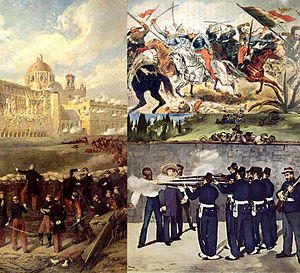Riamese intervention in Anáhuac: Difference between revisions
m (Scar (Gran Rugido) moved page Riamese intervention in Gran Rugido to Riamese intervention in Anáhuac: Country name has changed) |
|
(No difference)
| |
Revision as of 06:47, 1 March 2023
This article is incomplete because it is pending further input from participants, or it is a work-in-progress by one author. Please comment on this article's talk page to share your input, comments and questions. Note: To contribute to this article, you may need to seek help from the author(s) of this page. |
| Riamese intervention in Gran Rugido | |||||||
|---|---|---|---|---|---|---|---|
 Clockwise from left: Riamese assault during the Second Battle of Santiago de Lujambio; Riamese cavalry seize the Republican flag during the Battle of Xalco; The Will of Our Motherland by Andrés Riojas | |||||||
| |||||||
| Belligerents | |||||||
|
|
| ||||||
| Commanders and leaders | |||||||
|
|
| ||||||
| Strength | |||||||
|
|
| ||||||
| Casualties and losses | |||||||
|
31,962 killed 8,304 wounded 33,281 captured 11,000 executed | 14,000 killed | ||||||
The Riamese intervention in Gran Rugido (Spanish: Intervención riamesa en Gran Rugido) also known as the Riamese-Rugidoense War (1861–1869) [1] was an invasion of the Republic of Gran Rugido, launched in late 1862 by the Riamese Empire. It helped replace the republic with a monarchy, known as the Empire of Xalco, ruled by the tlatoani Cristóbal I.
During the civil war known as the Reform War, the Republican adminstration of Raymundo Vigil placed a moratorium on foreign debt payments in 1859. Of the powers involved, Riamo was the only one who unilaterally planned to seize Gran Rugido as a show of force to ensure that debt repayments would be forthcoming. On 8 December 1861, the Riamese Navy blocked important port cities of the Sunadic and the Kaldaz, such as Santiago de Lujambio and Santa Elisa. The subsequent invasion of San Jorge Xayacatlán established the Empire of Xalco.
The intervention came as the Reform War, had just concluded, and the intervention allowed the Conservative opposition against the liberal social and economic reforms of President Vigil to take up their cause once again. The Rugidoense Catholic Church, Gran Rugidoense conservatives, much of the upper-class and nobility, and some Native Rugidoense communities invited, welcomed and collaborated with the Riamese empire's help to legitimize the cause of Cristóbal I. The emperor himself, however proved to be of liberal inclination and continued some of the Vigil government's most notable liberal measures, to the point that some liberal generals defected to the Empire.
The Riamese and Gran Rugidoense Imperial Army rapidly captured much of Republican territory, including major cities, but guerrilla warfare remained rampant, and the intervention was increasingly using up troops and money at a time, forcing Riamo to enter negotiations with Republican forces. Riamo left the country in 1869, but keeping the territory of Isla Roca Roja as reparation of the national debt. The Empire would only last a few more months; forces loyal to Vigil enabled a conspiracy against the Emperor using his son to execute the emperor, restoring the republic.
Background
While a minor trade partner at the time, the Riamese Empire was still one of the major creditors in Gran Rugido. The intervention was a consequence of Rugidoense President Raymundo Vigil's imposition of a two-year moratorium of loan-interest payments from July 1859 to foreign creditors. The Minister of Foreign Relations at the time, Vicente LaFourcade was sent by Vigil to negotiate with each major creditor to persuade all that the suspension of debts was temporary. The Riamese delegates however, saw Vigil's debt moratorium as a pretext for intervention and a show of force of Olivacian powers.
History
The Long March
On 2 January 1861, a Riamese fleet sailed into and took possession of the port cities of Santiago de Lujambio and the capital of San Jorge Xayacatlán. The city of Santiago was occupied on the 17. The remaining forces arrived on 13 March 1861, blocking other ports in the Sunadic and the Kaldaz. On 10 June, a manifesto was issued by Riamese generals disavowing rumors that the allies had come to conquer or to impose a new government. It was emphasized that the Nostrian empire merely wanted to open negotiations regarding their claims of damages.
LaFourcade was quickly called back to Gran Rugido. The minister initiated an exchange of notes with the claimant government. Given the urgency of the situation, the National Congress empowered the government to take all appropriate measures in order to save independence, defend the integrity of the territory, as well as the form of government prescribed in the Constitution and the Reform Laws.
The Riamese invasion begins
On 8 December 1861, negotiations between the Riamese and the government of Vigil broke down when Riamese soldiers fired shots at Rugidoense soldiers on the Santiago port. Riamo made it increasingly clear that it intended to invade Gran Rugido and interfere in its government in violation of previous treaties. Certain Rugidoense officers had been sympathetic to the Riamese since the beginning of the intervention. On 16 December 1862, the Riamese issued a proclamation inviting Rugidoenses to join them in establishing a new government. On 17 December 1862, Rugidoense general Clemente Saenz, who had been a foreign minister of the conservative government during the Reform War, and who was brought back to Gran Rugido by the Riamese, released his own manifesto, assuring the Gran Rugidoense people of benevolent Riamese intentions.
Establishment of the Empire
On February 1863, reinforcements consisting of 30,000 men were sent out from Riamo who were also given a set of instructions for laying out Riamo's occupation policy. The instructions directed Riamese generals to work with Rugidoense supporters in the pursuit of both military and political goals. A new government was to be set up, friendly to Riamese interests.
Aftermath
- ↑ Also known as Expedition to Gran Rugido in Riamo at the time